



Featured Image: Johannes lands in San Francisco.
Traceroute – A Personal Journey Into the Uncharted Depths of Nerd Culture, A Realm Full of Dangers, Creatures, and More or Less Precarious Working Conditions. (Or Fear and Loathing in Nerdcore).
“In the end, we’ll all become stories” Margaret Atwood.
Before Vaporwave, Post-Internet, Facebook, and your latest Kickstarter campaign, there was the cybercultural counterculture. I encountered it through publications like Collapse, Mondo 2000, ReSearch, Fringeware Review, and bOING bOING (when it was still in print), and on BBS boards like The Thing and The WELL. This was the land of cyberpunk, Dead Media, Tactical Media, The Church of the SubGenius, online dungeons and wetware hacking. This is the native culture of Johannes Grenzfurthner, born of the dark forests of Austria, famous for music and mass murder (by his own admission), and a crèche for nerddom.
Traceroute (…) is a reflection on his own roots of nerddom, and an On the Road style romp across the United States as he visits icons of the counterculture, the outré, and the generally questionable.
He begins Traceroute with a fitting genesis story of his growing up in Central Europe, dressing like Captain Kirk, making treehouses and accidentally killing the family chicken with a failed science experiment, reading comic books, making short films, and being obsessed with Pachelbel’s Canon in D Minor. He saw that the neighbor’s patio tile always looked like LCD displays, and he started noodling around with his neighbor’s computer, logging into the FIDONet, learning about his nerddom, discovering ASCII porn, and Woschi Woschi Wau Wau, the Dog that Never Pooped. If you’re following me up till now, then you’ll get the general tone of the movie.
As Johannes expands on his arc from a gawky Austrian kid to founding the cybermedia group Monochrom in a quirky Germanic stream of consciousness, he decides to take his friends Jenny and Eddie on a trip across the US for a tour de farce into the depths of cyber-counterculture.
He begins his trip, of course, in San Francisco – home of the counterculture and the Californian Ideology, which he calls, “a fantastic realm of infinite opportunity and homelessness” There, he begins his intellectual trek across the USA with V. Vale – author and publisher of the ReSearch series of documentary books. Vale began his publishing career with a volume called Search and Destroy while working at the City Lights bookstore – a Mecca of beat culture. He cements the foundations for the film in saying that nerds made the counterculture; there is a sort of reflection that only comes from isolation or obsessiveness, and “There is no creativity in the absence of revolt.” says Vale.
Suddenly, I realize that I’m about a half thousand words into this review, and only about a quarter way through the movie, and barely out of San Francisco. That is the nature of Traceroute, a relentless stream of factoids and side trips that talks about many things, like the whiteness of cyberculture, the uncomfortable relationship between counterculture and neoliberalism, shipping containers, Area 51, as well as sci-fi props and makeup at Stan Winston Studios. This is the nature of the nerd; to be infinitely interested in infinite numbers of things, the more obscure the better. Actually, giving a feel for the film without describing it in total is probably the best thing to do, as it leaves many of the places Johannes goes to the imagination.
Traceroute has both memorable moments and stops that simply must be done if one is to visit cyber-counterculture. One of the mandatory stops is to SxSW Interactive in Austin, Texas and a chat with Jon Lebkowsky and Bruce Sterling. Jon is one of the founders of the legendary 90’s zine Fringeware Review and icon of Austin counterculture, as well as omniglot. Bruce Sterling, is of course, Bruce Sterling – cyberpunk author, WIRED Magazine blogger, and cyber-tastemaker. Listening to Lebkowski’s surprise at the traction of the cyberpunk movement in the 90’s in contrast to Sterling’s waxing of hanging with the tragically hip Milanese cyber-squatters of the time reminded me of the romanticism that also accompanies the underground.
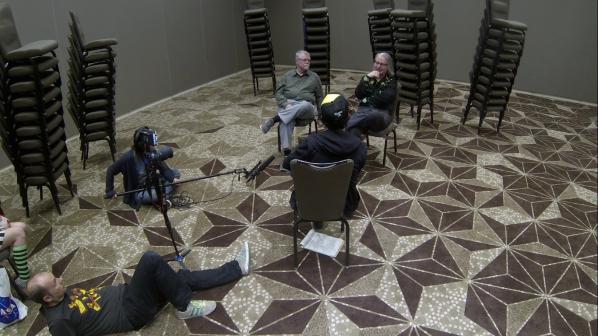
A fantastic moment was when the Traceroute crew actually winds up at the gate to Area 51 in the middle of the night and decide to talk to tactical artist Trevor Paglen to get more information about the site. Paglen, almost more than anyone, has done work that reveals “black” projects being pursued by the US government, such as stealth technology, spy satellites, the location of Internet ocean cables, and so on. During their conversation, Paglen brings up a mission patch for the US Air Force for a stealth project that has two things. First, there is an alien head, as it is Area 51 after all, and a caption that reads, “Gustatus Similus Pullus”, (or, Tastes Like Chicken). Frat humor in the skunkworks – hmmm…
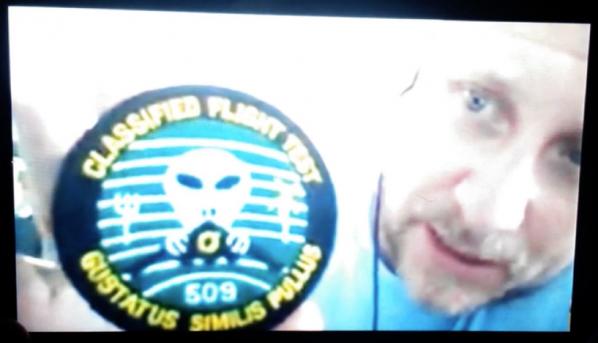
Grenzfurthner also muses that we are two things – sexual beings and tool users. This makes sense as his group Monochrom hosts the annual Arse Electronika festival (a sexual play on the Ars Electronica in Linz). This reveals itself in a number of segments with Miss Maggie Mayhem (San Francisco), Kit Stubbs (Boston), Christina Anapakis (Los Angeles, who does art from body cultures), and Bad Dragon, a company that does science fiction/fantasy dildos. From Maggie’s playfully powerful illustrations of the links between sex work and Silicon Valley to Christina’s experiments with Johannes’ culture to make a failed cheese, I am happy to see that Monochrom’s sex and body-positive message that nerds are filled with a curiosity about all of the world around them is present in Traceroute.
My only complaint about the movie is that I wanted more of it, or perhaps more of the eastern US, as it is nearly three-fourths of the way through the film before we leave Austin. Perhaps the newest part of the country, the West, might be the weirdest, but I’ll leave that to Johannes. And there are tons of other alternative cultural sites to go, like the Museum of Jurassic Technology and Craig Baldwin’s Artist’s Television Access in California, and Rich Pell’s Center for Postnatural History, the Mystery Spot, but he had a week, and only two hours of video. But on the other hand, I’m giving inordinate attention to the first half of the film, so not only am I self-referentially riffing on Grenzfurthner’s narrative style here, but mimicking the structure of the movie.
Lastly, anyone dealing with outré culture that mixes nerddom and capitalist critique has to go to Monroeville, Pennsylvania – site of George Romero’s marvelous political zombie flick, Dawn of the Dead. They go to Monroeville Mall, the site of the movie itself, with leftist critic and game designer Paolo Pedercini. There is a certain poesis about Paolo ranting about consumer culture, nerddom, the nexus of the mall and the surveillance state while waiting for the security guards at the mall to show up. These remarkably self-referential shots are what makes Traceroute magical.
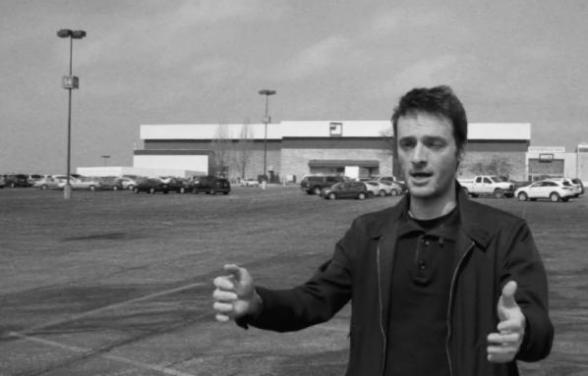
After watching Traceroute, I was left with a real exhilaration and a deeply reflective feeling at once, but I think this would be similar to Grenzfurthner’s experience on his ur-nerdtrek across the USA. I mean, except for being a decade older, we have a lot in common. Our upbringings were similarly nerdy, but mine in Ohio, and his in Austria, he started Monochrom while I was with RTMark, we have many friends in common in the film, and we’ve glancingly communicated for decades. And he just made the documentary of our shared subculture. Of course, I’m going to like this film.
However, I wondered – what about the relevance of cyberculture and the counterculture in the age of Facebook and postinternet slickness? I mean, what role does Traceroute’s subject matter have in the light of neoliberal, hyperprofessionalized cultural production evident in the mid-2010’s? But then, the words of Sandy Stone, an eternal voice of reason, rang out in my mind. She said that William Gibson (and I’d add, Sterling and the rest of the cyberpunks as well) wrote this future, and a lot of it came true. And it sort of went to shit, and we’re still doing it, and it’s all good. And I’d like to expand in saying that not just cyberculture, but counterculture just keeps going, and the fact that it’s from the 80’s or 90’s (or the 60’s, for that matter) makes any difference. What Johannes terms as nerd culture is merely many aspects of Western counterculture, and it’s a tradition that has given rise to everything from the Summer of Love to the personal computer (and that’s just San Francisco…). What Traceroute reveals is the tradition of alterity just beneath the surface of Western culture, and that it has a powerful effect on our mass consciousness, whether it is in plain sight or not. Traceroute is debuting at the NYC Independent Film Festival, April 27-May 1, 2016.
The Rubix Cube is is not the only twisty puzzle. Learn about Pyraminx, the 2×2 and 4×4 cubes, the Megaminx on Ruwix.
Featured image: A live portrait of Tim Berners-Lee (an early warning system). Thomson and Craighead. March 2012.
Flat Earth was published to accompany two solo exhibitions. The first, Not even the sky at MEWO Kunsthalle, Memmingen, Germany from 26 October 2013 – 6 January 2014 and the second Maps DNA and Spam at Dundee Contemporary Arts, Scotland from 18 January – 16 March 2014. The book contains a foreword by Axel Lapp, essays by Dundee Fellow Sarah Cook and DCA Director Clive Gillman as well as an interview with the artists by Steve Rushton.
On the whole, the mainstream art world has failed to ‘convincingly’ adapt to (new) media art and similar contemporary art practices using networks and technology. Thomson & Craighead have overcome this impasse and this is one of a few reasons why they’re so interesting to look at as contemporary artists. The book, Flat Earth does not propose to cover all of their art and this review does not propose to cover all that it is featured in it. The review features Flat Earth Trilogy, The End, October and TRIGGER HAPPY (not in the book).
“Their work provides us with a new perception, through
a completely unexpected multi-focal perspective. They reveal
the wide ramifications of systems of information exchange and
provide us with an insight into the resulting infrastructure of
our own thinking.” [1] (Alex Lapp 2013)
TRIGGER HAPPY: Shooting The Messenger.
Although TRIGGER HAPPY (1998), is not featured in the publication it provides a useful introduction to some of the ideas and conceptual approaches present in Thomson & Craighead’s later artworks. I first experienced the work online, but it’s also a gallery installation that takes the form of an early shoot-em-up arcade game, Space Invaders. This work reflects the sly and cheeky side of Thomson & Craighead and tells us how humorous they can be in their art. TRIGGER HAPPY is philosophical and playful. It asks the player to shoot down the text of Michel Foucault’s essay What Is an Author? published in 1969. [2]
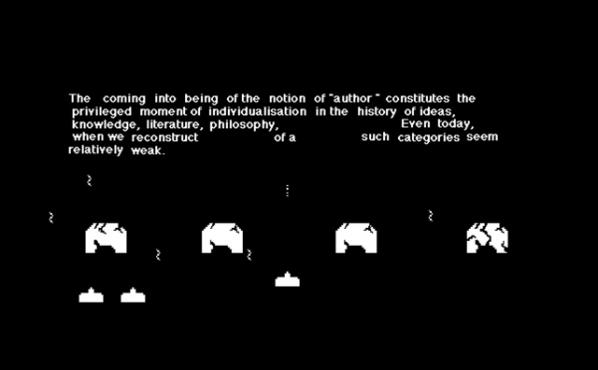
Foucault said the depiction of knowledge is a production and truth is produced, and it is always a reconstructed falsification. In a way TRIGGER HAPPY gives us a chance to shoot at Foucault, who in this respect is the annoying messenger. At gut-level, this art object recognises that on the whole we prefer to shoot at things or play games, than to deal with the complex and pressing questions of our time. Even if the gamer does manage to destroy Foucault’s text, this action prompts an existential enactment of doubt and induces a more vulnerable state of interpassivity. This relates to the illusion of agency when playing games, using corporate online platforms like Facebook and other experiences involving interaction with media, and it can also be extended to life situations. Slavoj Žižek proposes that interpassivity is the opposite of interaction and says “that with interactivity a false activity occurs: ‘you think you are active, while your true position, as it is embodied in the fetish, is passive’. Žižek refers to the Marxist notion of commodity-fetishism to imply that social relations are increasingly reduced to objects (Žižek, 1998).” [3]
We can almost hear the catchphrases “it’s only a movie” or “it’s only a game” as we are compelled to shoot at rather than attend to the messages that may serve to enlighten us and free us from our societal conditioning.
Flat Earth Trilogy: A networked society’s gaze at its mediated self.
The Flat Earth Trilogy is a series of documentary artworks each made entirely from information found on the World Wide Web; with fragments collected from people’s blogs, This covers a six-year period beginning with Flat Earth (2007) A short film about War (2009/2010) and then ends with Belief (2012).
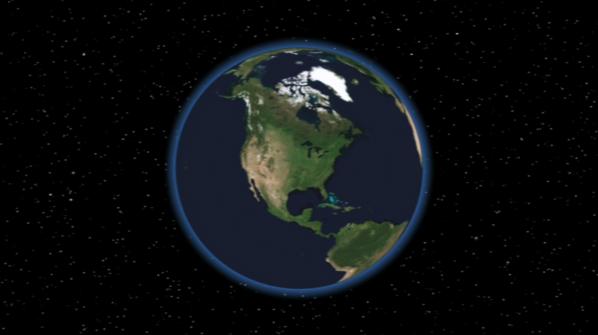
Commenting on A Short Film About War, on their website, Thomson & Craighead write “In ten minutes this two screen gallery installation takes viewers around the world to a variety of war zones as seen through the collective eyes of the online photo sharing community Flickr, and as witnessed by a variety of existing military and civilian bloggers.” [4]
In the book Flat Earth Steve Rushton discusses with Thomson & Craighead why he feels A short film about War works for him best. He says, “It seems to make a claim on truth – which is the traditional claim of the documentary in particular and photography in general – whilst at the same time it shows us that truth is constructed.” [5] (Rushton 2013)
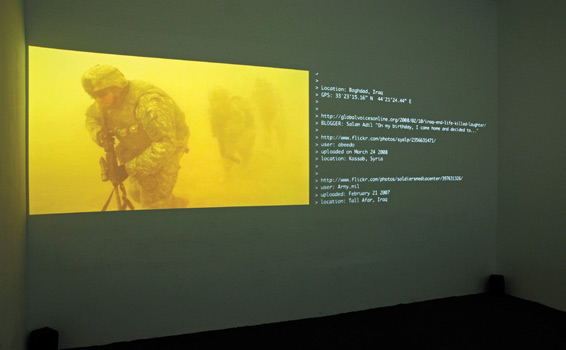
These works challenge our notion of what a documentary is, what and who the author is, and leaves us with the question, what does this mean for the wider society? This brings us back to Foucault’s ideas on the production of truth and its falsification. Tom Snow writes “In the essayistic act of image compilation then, the piecing together of filmic clips and stills distorts the dividing line between fiction and fact, and reimagines the enigmatic relations between photographic mediums and the condition of representation.” [6] (Snow 2009)
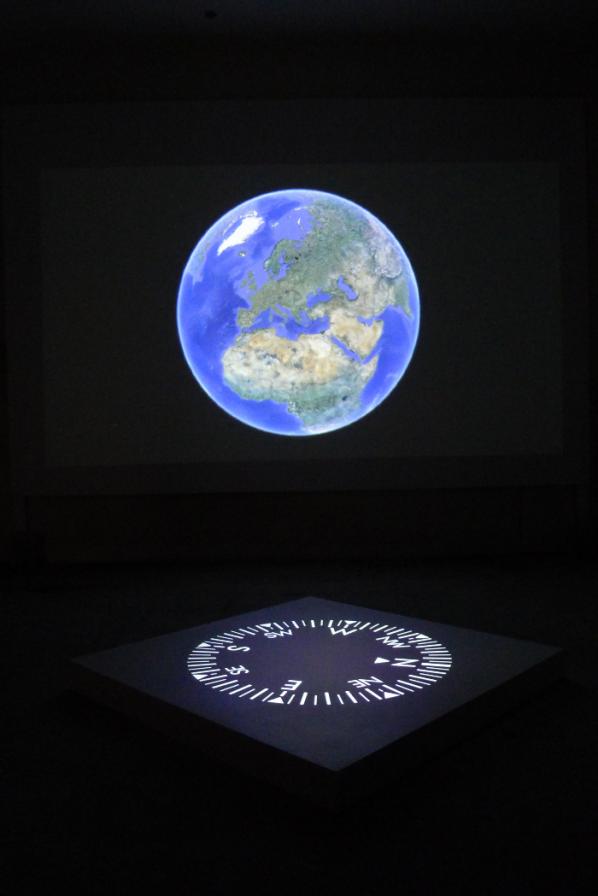
Flat Earth, A short film about War, and Belief all relate to topics concerning human values, conflicts, militarism and everyday societal struggles. “Machines,” wrote Gilles Deleuze in his examination of Foucault’s thought, “are always social before being technical. Or, rather, there is a human technology before which exists before a material technology.” [7] (Berger 2014) And so the technologies we produce are another materialization of the continuing human story.
Millions of people, en-masse, are uploading their personal data (different indications of their states of being) to a collective assemblage. Alex Galloway says that in order to get a better understanding of what networks are we must put aside the idea that networks are a metaphor. He proposes networks as part of a materialized and materializing media. He views this as an important step toward understanding the “power relationships in control societies.” [8] (Galloway 2004)
“It is a set of technical procedures for defining, managing, modulating, and distributing information throughout a flexible yet robust delivery infrastructure.” And “More than that, this infrastructure and set of procedures grows out of U.S. government and military interests in developing high-technology communications capabilities (from ARPA to DARPA to dot-coms).” [9] (Ibid 2004) Galloway’s distinction helps us to re-evaluate what he sees as distracting tropes and uncritical interpretations of the Internet, the World Wide Web and Web 2.0.
Thomson & Craighead provide parallel insights through their artwork into the protocols and technical procedures governing the functions of networks. However, human existence and human experience has a relationship with these networks and, out of millions of interactions, evolves not metaphors but fragmented symbolisms and stories. These are telling us about a networked society’s gaze at its mediated self. And this is where art can play a special role in critiquing, communicating and sharing the nuances of this emerging multitude.
The Flat Earth Trilogy presents us with a complexity where everything is flattened out. It maps out a human psyche from an anthropological perspective. And this leaves society to deal with issues concerning the human condition entwined within a machinic evolution.
This evolution has no physical body even if real lives and bodies are its source material “each mode is displaced by machinic evolution, mixing flows and the shifting codes and overcodes of power, the base forms continue onward, written directly into the heart of the system.” [10] (Berger 2014)

To further understand this work in relation to the machinic evolution, the networked gaze, and human interaction, I feel there is some value in considering hyperreality “…a condition in which what is real and what is fiction are seamlessly blended together so that there is no clear distinction between where one ends and the other begins.” [11] Hyperreality is a post-modern term used by Jean Baudrillard, Albert Borgmann, Daniel J. Boorstin, Neil Postman, and Umberto Eco. However, if we add a contemporary flavour to what hyperreality looks like now in a networked society we come up with hyper-mediality. “What we refer to as reality very often is just mediality, and also because that’s how human nature often prefers to observe reality, you know, via some media.” [12] (Ubermogen 2013)
We can see an example of this condition in an artwork by artists’ Franco and Eva Mattes, with their performance video No Fun (2010) [13] where they staged a suicide in the popular webcam-based chat room Chatroulette.
“Notably, only one out of several thousand people called the police. Moving beyond the aspects of shock and provocation, this touches on a basic question: What does “reality” mean in the digital age?” [14] (Eva & Franco Mattes)
The Flat Earth Trilogy throws up many questions and you’d be forgiven for thinking we need another book to fully examine the ramifications of these artworks. Instead let me to refer you to other related texts by Tom Snow, Edwin Coomasaru, Jo Chard, and Alan Ingram by clicking here http://www.inmg.org.uk/archive/thomson-craighead/catalogue/

Shifting Sands.
Clive Gillman in his essay in Flat Earth says “if artists are to find a way to assert a commentary or expression through these emerging forms of contemporary media, they will have to do this by reconciling the resistance of these new media objects to be ordered into a form that may represent a recognisable notion of artistic intent. And it is into this challenge that Thomson & Craighead pitch themselves.” [15] (Gillman 2013)
It is not the audiences who have difficulties with emerging forms of contemporary media it is the mainstream art world, and this is most of its magazines, galleries and museums. From our own experience of showing art and technology at Furtherfield Gallery, audiences tend to be adventurous and open-minded regarding their experiences with technology and societal issues. And yet the art world has had difficulties making a place for this work.
Sarah Cook and Christiane Paul, both curators well versed in the field of media art, have tirelessly offered us convincing arguments why this is. Christiane Paul says, “Many curators and other practitioners in new media seek to “teleport” the art out of its ghetto and introduce it to a larger public.” [16]
Sarah Cook says “artists who are really working with technology are still redefining art. So they’ll always be “in emergence” [..] They always will try to change the boundaries of what we think Art is and challenge the institutions that show it.” [17] This is true with Thomson & Craighead’s installation and networked artwork. It is plugged directly into a larger, expansive, worldly discourse, in contrast to traditional modes of artistic and news presentation which are highly restrictive and contained within their mediated monocultures.
Gillman proposes that Thomson & Craighead are pitching themselves to create art which is a recognisable notion of artistic intent, and other artists should do this also. I am assuming this is so the work is recognisable as ‘art’ to the mainstream artworld and its traditional remits. This is a strange ask if you are an artist who is truly exploring further than what is typically expected by mainstream art culture. I would argue that artistic context and its values are not fixed and that’s the point. If artists become too self conscious in trying to make their art look like an art that “fits”, it then looses its imaginative edge and critical reasoning.
It’s a difficult balancing act if the artist is examining deep or necessary questions whilst the current art world is lagging behind in so many ways. Julian Stallabrass sees this lagging behind as a political issue. In his book Contemporary Art: A very Short Introduction, he critiques the blocking of emergent, and critically engaged artistic expression as part of a ‘New World Order’ where we are constrained by a compliant culture controlled by the rampant demands of a corporate elite, who only consider art in terms of economics, markets and brands. And these restrictive and dominating frameworks are dedicated to the neoliberal promotion of privatisation and growing inequalities.
In his article ‘Reasons to Hate Thomson & Craighead’ he says “At this point, the art professional sees a world crumbling, visions of empty galleries, unique works owned by everyone, a stuttering and then failing of artspeak amid a mass proliferation of ‘work’ and comment, the autonomy of art ruptured, artists and dealers redundant, in short an economy broken and the sacred polluted with the profane. Naturally, representatives of the old order, more or less sharply aware of dark clouds gathering at their horizons, have good reason to hate Thomson & Craighead.” [18] (Stallabrass 2005)


Thomson & Craighead’s work connects with people and they know this because they use content and themes people are thinking about in their everyday lives. This is what makes the series of documentary artworks so powerful. It assembles what is going on in the world in ways that traditional documentary and news channels are not. And this is their real challenge, because if they continue to reflect human culture as it happens with works like October – a documentary artwork about the early rise and fall of the Occupy movement – they will be highlighting messages from a world of people in need of something different than what is currently in place, whether this is deliberate or not. This art has a strange irony, it not only asks us what a documentary is, but it also asks what is news?
The End.

The End is a site-specific artwork first shown at the Highland Institute of Contemporary Art in 2010, Scotland. It is situated in one of the gallery rooms at H.I.C.A that has a large, wall-sized window looking out onto the countryside in the Highlands. It is an intervention into the space where the words ‘The End’ are fixed onto the glass in a style and scale one might associate with the end credits of a movie.
The combination of the outside natural environment, the galley building with its large glass window, and the added text, are assembled together to build a whole artwork. If any these components were taken out of the assemblage it wouldn’t work. This tells us how well crafted Thomson and Craighead’s work is and how much attention is paid to detail.
When looking at The End, one cannot help feeling a little out of sync. It is like a monument or an obituary for a lost world or lost time when we were all standing on solid ground and felt we knew what was real and not real. The End brings into play the rhythms of a larger natural environment and works as a bridge between two worlds or the illusion of it. It reminds us we are no longer experiencing the world face on or directly, but the world is re-introduced to us mainly through screens, televisions, mobile phones and our computers. It also invites us to imagine as we look out on the beauty of the natural world that we are viewing the end of our own role in the story of humanity.
The Situationist, Guy Debord said that people’s alienation was once about having things and claiming better working conditions, but then it moved onto being about a state of appearing. Meaning, it is not producing things, or even owning things that drives society but rather how things appear and how they make us appear. The glass acts as a filter and an interface, a place of safety distant from the touch of the wild. Its physicality, metaphors and symbolism offers a poetic moment for us to consider how perceptions about ourselves and ideas concerning real-life have changed, and what this means.
On the DCA website as part of its commentary about the book, it says Flat Earth presents Thomson & Craighead as pioneers in the field of new media for nearly twenty years. Sarah Cook and Christiane Paul also deserve credit as pioneers for recognising, supporting and dedicating their lives to creating the contexts in contemporary art culture for Thomson & Craighead’s work and other artists’ works. Also, Cook has edited a fine publication. Flat Earth is well designed and the whole book is meticulously well put together with quality images throughout. The mix of inteviews and essays with Thomson & Craighead give the reader a well balanced overview of their the art and their ideas, it is unpretentious and explores their focus as creative and thinking individuals artistically, conceptually and critically. We need many more of these types of books to support this dynamic and ever-changing field.
Thomson & Craighead dig deep into the algorithmic phenomena of our networked society; its conditions and protocols (architecture of the Internet) and the non-ending terror of the spectacle as a mediated life. When reading the Flat Earth publication, you get a clear impression of their conceptual rigour. They know their place and role as artists in society and this is well presented in the book. Their collaborative journey has remained faithful to the World Wide Web, and the Internet as a focal point and a content provider for their art practice.
It would be simplistic to assume they are embracing technology as a celebration of its progress. Their critical scope examines big issues and this is evident in Flat Earth. They belong to a generation of artists who are experimenting with real time data, networks, web cams, movies, images, sound and text; as part of an anthropological venture that studies humanity’s relationship with technology, alongside the inane and profound nature(s) of the human and non-human condition. We exist at a point where ubiquitous computing now redefines our point of presence, shifting our perceptions in reference to cultural tags and repeated experiences of mediation. They successfully critique these changes. Not only to other artists, curators and galleries, but to all who are being transformed by technology and this is what makes them essential and contemporary.
Thomson & Craighead are not just making and showing art they are also presenting questions. These are not invented questions they are already out there. But, just like some need an interpreter to translate different dialogues they are assembling for us the dialogues of an emergent multitude.
Featured image: The Last Collaboration, cover image
Read The Last Collaboration online
“The United States loses more American lives to patient safety incidents every six months than it did in the entire Vietnam War.” Edward Picot introduces The Last Collaboration an art documentary book by artists and poets Martha Deed and Millie Niss. This work is a construction of Millie’s hospital experiences in the last hospital she ever visited. The story is told through Millie’s notes, emails, the daily diary she sent home, her posts on her Sporkworld blog, her mother’s log, and Millie’s medical records. These primary, often raw, documents are framed with medical notes and clinical guidelines as well as the outcomes of two NYS Department of Health investigations of Millie’s care. Millie wanted her story told. She wanted an autopsy performed if she died. Because of the autopsy, we have the story.
At 09:57 on the morning of 15th November 2009, Millie Niss sent an e-mail from her hospital bed to her parents:
…they have an inexperienced person treating the sickest patients… and by the time she knows enough to do a good job, she is burned out & ready for a part time practice. They should have inexperienced doctors treat the least sick patients, not the sickest ones… This is true in every specialty and I am sure patients die as a result.
She had been in hospital for two weeks, by her own account she had already come close to death, and in another two weeks her life would be over. Already she was unable to move, catheterised, usually in pain, and on a ventilator which prevented her from communicating verbally. Not many patients in her position would have the energy to analyse their own care, never mind write down their conclusions so lucidly. But Millie was no ordinary patient.
She was a writer and new media artist: she had been seriously ill with Behcet’s Disease for years – virtually a cripple – but her artistic powers were undiminished, and with the help of her laptop and the internet she continued to work and communicate. When she was admitted to hospital with swine flu, it still didn’t stop her writing and thinking. She actually sent off a contribution to a new media project from her hospital bed. She listened to WNYC during the day and BBC4 at night. She couldn’t talk, but she kept up a constant stream of e-mails and handwritten notes – to hospital staff, to her parents, and to friends online. She wanted to record everything and comment on everything. If she died – which she could always see was on the cards – then she wanted an autopsy, and she wanted the story of her death to be told.
The remarks quoted above show how acute she could be. She has put her finger right onto a recognised problem of healthcare – that the most complex and stressful cases are often looked after by the least experienced practitioners. Senior doctors are often all too glad to distance themselves from the front line as soon as they get the chance. In a way this is completely understandable, but as a result front line work is frequently characterised by an atmosphere of muddling through, which can rapidly degenerate into bluster, hysteria, bullying and panicky incompetence when the going gets tough.
This book is an account of Millie’s experiences at the front line during her final illness. She was hospitalised in New York State, but I can recognise many of the problems described herein from my own experience of the NHS in England, where I have worked in a doctor’s surgery for more than twenty years. The story has been assembled by Martha Deed, Millie’s longtime collaborator and Mom, using not only Millie’s e-mails and jottings, but her own own notes made at the time, her reflections since (which often take the form of poems), and the results of her subsequent investigations and complaints. In artistic terms the different elements are blended and balanced with great skill, and we find ourselves shuttling between documentary evidence, poems about bereavement, first-person narratives and nature-notes about birds, without any sense of incongruity or disjunction. The story unfolds both in the present tense and in flashback, both from Martha’s point of view and from Millie’s. It is a shocking depiction of how badly things can sometimes go wrong in a hospital.
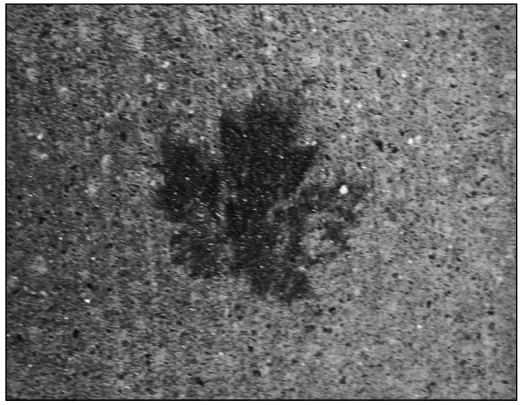
Doubtless the hospital would argue that this is a one-sided account. They would also say – indeed, in their response to Martha’s complaints they did say – that Millie was not the easiest patient to care for. And leaving Millie’s case on one side for a moment, it has to be admitted that caring for the sick, especially in a hospital, is an extremely difficult job. Unreasonable behaviour from patients may not be the norm, but it is certainly commonplace. At least in a doctor’s surgery you can get to know your clientele over a period of years, and they can get to know you. In a hospital the turnover is much higher, and bonds of trust are correspondingly more difficult to form. People are generally sicker, which makes them more stressed; and relatives are more worried, which makes them more demanding. Furthermore some people simply cannot accept the realities of ill-health and death, and lash out or place blame as a means of relieving their feelings. Perhaps it’s not surprising, therefore, that some hospital employees come to regard the patients – and their families – with a mixture of nervousness and resentment rather than sympathy and helpfulness.
The best carers can deal with tricky customers without losing their cool. They avoid getting into confrontations and status-competitions with the public, and they treat the people they don’t like with the same meticulous care and respect as the ones they do. They are not only skilled and sympathetic, but detached enough to keep a sense of perspective at all times. They make good decisions in pressurised circumstances. They communicate clearly at every stage of the caring process. They admit their own shortcomings and seek expert help when they need it, instead of trying to bluster and bluff their way out of difficulties. Unsurprisingly, a lot of employees in the health service fall a long way short of this ideal; but what is less excusable is that some of them don’t even recognise it as the ideal for which they should be aiming.
What these pages make painfully clear is that although hospital staff are supposed to treat all patients the same, they can sometimes be prejudiced against certain types, for example the obese, who are often regarded as having created their own health problems. Furthermore, although they officially welcome questions and comments, in practice they tend to prefer grateful submissiveness, and there are those who interpret anything else as troublemaking.
Of course, Millie’s story mustn’t be taken as representative of what’s likely to happen to anyone who goes into a hospital, either in the UK or the USA, and it mustn’t prevent us from realising how hard people in healthcare generally work – a lot of them for not very much money – or what an invaluable job most of them do.
All the same, the situations described in this book will strike a chord with many people both inside and outside of the health care sector. One thing it lays bare is that the psychology of caring can be a disturbing subject. We are such touchy creatures, so desperate to justify ourselves and not lose face, so anxious to get the better of anyone who seems to pose a challenge, that in no time at all, even when another person’s health is at stake, we can forget our duties and become embroiled in a petty struggle for the upper hand. Furthermore power corrupts, and a health care worker is in a position of power, able to grant or deny favours, wielding the authority of the surgery, the hospital or the System itself.
And then there is the impossible-to-ignore feeling that the patients are making our lives a misery by forcing their demands upon us. Even outside the health system, when we are caring for our loved ones, our concern for them is rarely untainted with resentment – why can’t they leave us alone instead of pestering us for help all the time? So what chance is there that staff in a doctor’s surgery or on a hospital ward will be able to avoid upsurges of ill-feeling towards the patients, particularly when things get difficult? And once they have taken a dislike to someone, they may subject that person to obstructiveness, bossiness, bullying, uncaring treatment or even cruelty.
Hopefully, to recognise these impulses and their grounding in normal human feelings is the first step towards controlling them. Unfortunately, people coming into health care are usually given very little training in its psychological aspects, and what training they do get tends to be so simplistic that it’s difficult to apply in real-life situations.
Furthermore what happens on the front line, as Millie so shrewdly observed, is very often a knock-on consequence of organisational decisions made higher up. If senior members of staff use their seniority as an excuse for distancing themselves from the most stressful and difficult areas of work, then those areas are going to be looked after by juniors. Mistakes are more likely to be made, and although the senior members of staff won’t be the ones making them, they will be indirectly responsible.
In badly-managed organisations leaders and decision-makers tend to become detached figures issuing edicts from ivory towers, and because of their detachment those edicts become increasingly abstracted from the realities of working life. “Ordinary” members of staff are left to muddle along as best they can. Organisations like this are often characterised by high-sounding written policies which nobody ever reads or puts into action – and there are examples of such policies in this book.
In the best-run teams, leaders and decision-makers do not become separated from the rank-and-file: everybody communicates with everybody else, everybody plays a part in the decision-making process, everybody knows what’s going on and continuity of care is ensured. But this book shows what can happen at the other extreme: fragmentation of care, no coherent plan, rogue individuals doing pretty much what they like, poor communication, needless delays, and ultimately fatal errors.
Then there are the questions of incompetence and cover-ups. Nobody is immune from making mistakes, and the best individuals and institutions are able to recognise them and learn from them. Yet people in all walks of life just as frequently react to criticism with defensiveness and self-justification, or by simply brushing things under the carpet. Again, these are perfectly normal reactions in a way: no matter how rewarding it may be to learn lessons from our own failures, it is always an uncomfortable process, and our first impulse tends to be either to deny them or hurry away from them as soon as possible. In the health service this reluctance to acknowledge mistakes can shade into blaming patients for their own difficulties, or trading on the disinclination of relatives to trawl through the details after someone has died. The death of a mismanaged patient can even come to be regarded as a desireable outcome, since it usually has the effect of silencing criticism and drawing a veil over people’s mistakes. All of these things seem to have happened where Millie was concerned.
Needless to say, given its subject, this book can be a tough read at times. But it’s full of insightful comments – here are just a few examples:
Do not confuse personality or communication skills with medical competence. It’s great to have both, but the more important quality – absent personal nastiness – is medical competence. [Martha]
I have also gotten a lot of good care, but once you die or are terribly damaged it is too late to say “Most of the care was ok”. [Millie]
You would not believe how nasty nurses can be to people who are very sick and helpless. [Millie]
I am sorry, my dear,
but the leg you say is broken because it looks all twisty and it hurts…
is not broken
because we have met our broken leg target for the month.
[Martha]
As these quotes show, the style in which the book is written, even when the subject-matter is at its grimmest, is always natural and engaging. And although, in places, the narrative shows us some unsavoury aspects of human nature, Millie is such a living presence, and the relationship between her and her mother comes across so powerfully, that what we are left with in the end, paradoxically, is a sense of affirmation.
It is encouraging to learn that a medical professor in the USA is already planning to use The Last Collaboration as a training aid. It could well prove invaluable, not only as a cautionary tale of how things can go wrong in the health care system, but as a tremendously vivid insight into what it feels like to be on the receiving end when they do. Given the choice, Millie would undoubtedly have preferred to escape with her life rather than achieve this particular form of immortality. Nevertheless, she would certainly be gratified to know that her story was making a difference. It is a story which she desperately wanted to be told, and which needed to be told for the good of the health service and its patients. And almost all of us will be its patients one day.
—
Read Edward Picot’s article about Millie Niss on Furtherfield
Featured image: Lynn Hershman Leeson Portrait (Photo Credit: Ethan Kaplan)
Woman, Art & Technology is a new series of interviews on Furtherfield. Over the next year Rachel Beth Egenhoefer will interview artists, designers, theorists, curators, and others; to explore different perspectives on the current voice of woman working in art and technology. I am honored to begin this series with an interview with Lynn Hershman Leeson, a true pioneer in the field who has recently produced !Women Art Revolution- A Secret History.
Over the last three decades, artist and filmmaker Lynn Hershman Leeson has been internationally acclaimed for her pioneering use of new technologies and her investigations of issues that are now recognized as key to the working of our society: identity in a time of consumerism, privacy in a era of surveillance, interfacing of humans and machines, and the relationship between real and virtual worlds. She has been honored by numerous prestigious awards including the 2010-2011 d.velop digital art and 2009 SIGGRAPH Lifetime Achievement Awards. Hershman also recently received the 2009 John Simon Guggenheim Memorial Foundation Fellowship, an award which supported her latest documentary film !Women Art Revolution – A Secret History.
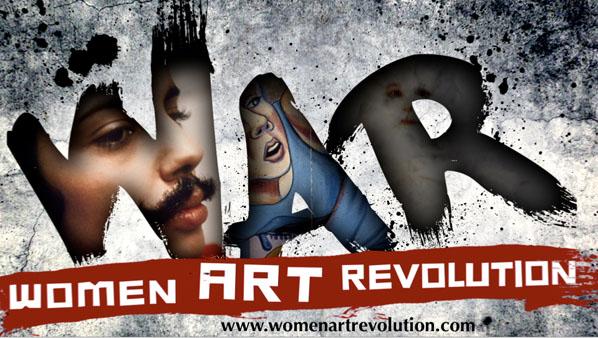
Rachel Beth Egenhoefer: Your most recent project is the film “!Women Art Revolution” which you have been collecting materials for and working on for the past forty years. Why is now the time to present it as a finished work?
Lynn Hershman Leeson: TECHNOLOGY! The film is one narrative, but I’ve put the entire 12,428 minutes online through Stanford University Library, making all the narratives and aterials accessible, so in effect there are no out takes. Also the RAWWAR org archive/website allows people to continue the story online. So the story continues to grow beyond the single narrative, which technology allows us to do now.
Additionally, I wanted to push out into public view the graphic novel, curriculum guide, and the story to affect the legacy while women who created the movement could be appreciated.
RBE: Can you expand on how you see the RAWWAR story continuing online? Or maybe what is the goal of the archive/website? Do you envision people adding to it?
LHL: Yes, it was made specifically so that people, especially younger generations will be able to add information. At the Walker Art Center, they have scanning stations and are training people how to upload work onto the site. My hope is that people from around the world will add materials and it will be a living repository of this type of growing and accessible information.
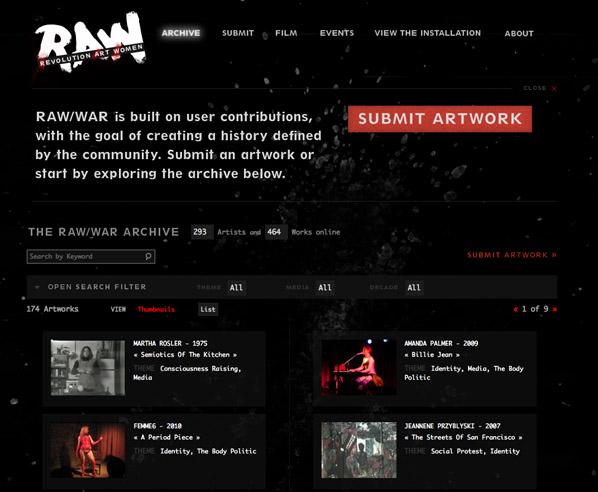
RBE: The film has been touring in the U.S., what has the response been?
LHL: Incredible. It has been in over 60 cities, and standing ovations in San Francisco, Houston, Toronto, Sundance, Berlin and Mexico City. People seem deeply affected by this secret history and seem to appreciate knowing about it.
RBE: Has the response varied either with geography or current events?
LHL: Not really, it seems vibrantly appreciated worldwide despite it being about women in America.
RBE: Can you explain the grammar behind the title “!Women Art Revolution”?
LHL: If you mean why the ! first, it was so we would be listed first, rather than under W. It didn’t work, but that was why we did it originally. It also is a wild exclamation at the start, which is what the movement was.
RBE: The film is described as presenting the relationships between the Feminist Art Movement and the anti-war and civil rights movements, showing how historical events sparked feminist actions. Do you see any connections to be made with the current Occupy Movements?
LHL: Yes, absolutely. In some ways because it is about how the disempowered and invisible people were able to gain their place in culture; how people who had their voices silenced were able to amplify their message and subverted social systems, with work that expressed censorship, freedom of expression, social justice and civil rights and directly made political change. It is an inspiring story of reinvention.
The goals were clearer than with Occupy. But the disenfranchised edges of culture is similar.
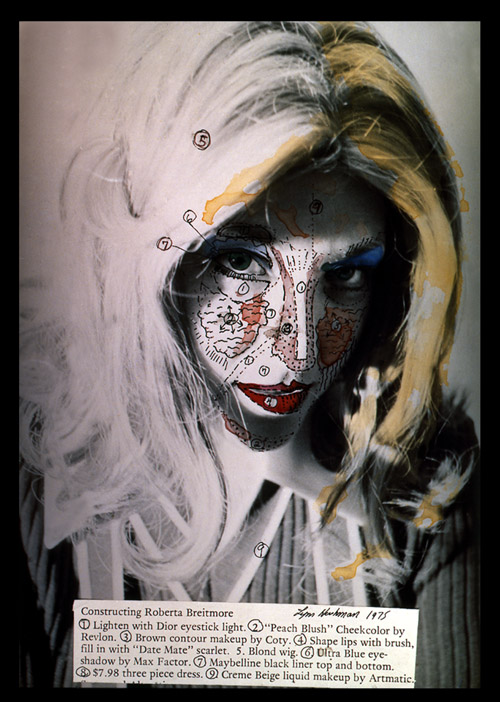
RBE: A lot of your early works dealt with issues of identity. How do you think the notion of identity has changed over the years?
LHL: It has become more technological, more global, more cyborgian. We now, because of the internet are linked globally and that has resulted in a “hive mind” and in turn, that seems to be a cohesion and holding together the individual fracturing that had occurred over the last two decades
RBE: Can you expand on the idea of the “hive mind that seems to be holding together the individual fracturing”? What makes up the hive, what is fracturing us? Is this good or bad or neither?
LHL: The hive is social media and people who participate in the Internet grammar. There is a congealing through access to information. As individuals, I think we have been fracturing, rupturing, split for decades and have become multi faceted and multi taskers. But there’s a price in the lack of personal cohesion that results. I think that having a common reference or ‘hive’ is a very good thing, as it tests our idea of ‘reality’, and serves as a hub of communication.
RBE: Do we make our own hives? Or are those defined for us (either by others/ FaceBook/surveillance/ etc)?
LHL: We are all part of global re-patterning that is happening live on a global scale and it is naive to assume we can act independently or not be connected or affected. We are constantly challenged, influenced by peripheral and pervasive information and in turn we have become fodder for surveillance and digital integration.
RBE: Some contemporary artists and thinkers have been critical of our online selves and physical selves. Sherry Turkel for instance has described people as “performing themselves” online by constantly updating Facebook profiles, tweets, etc to show an ideal version of ourselves. Can you draw any distinctions between virtual, physical, and performative selves?
LHL: I think we perform ourselves every day, not only on social media, but in all interactions. I do not think all images or versions of ourselves are ideal. There is absolutely a difference between real/physical and virtual selves. They each have a context, reference and function. As far as being performative, that depends upon the distinction used for how it is used. One can, in fact, consider life itself and everything one does as performance.
RBE: This interview is going to be part of a series of interviews with women working in Art & Technology. What do you consider to be important today about being a woman working in art & technology?
LHL: Ada Lovelace wrote the first computer language, Mary Shelley envisioned artificial intelligence, Hedy Lamar invented spread spectrum technology, which led to cell phones. Women have been enormously prescient in visioning and affecting the future of the world through technological linkage systems.
RBE: Do you think it is still useful to discuss the female voice as a separate voice in the field?
LHL: I think the female voice is critical in all aspects of the future and should not be limited to a category.

RBE: One of your earlier works, LORNA, depicts a woman who never leaves her apartment and becomes more and more fearful as she watches ads and news on the TV. Some might say television media has gotten far worse since the 80s in both fear mongering and controlling conversations. What do you think about the current state of the media?
LHL: Right, the idea of media as totally affecting our outlook has shifted. Media is no longer omniscient! The 99% are activating their voices and warbling into existence. There are other problems with social media… deeper ones that splay into the cracks of fractured identities and insist on more disruption and lack of focus. But perhaps that is what is affecting our constantly changing evolution.
RBE: If LORNA were around today what would she be thinking or doing in her little 1 room apartment?
LHL: Blogging and all forms of social media including excessive and obsessive shopping, no doubt. She would probably not really be agorophobic either. She would, however, probably be paranoid. She would use a webcam and notice all the ones surrounding her no matter where she moved.
RBE: Do you have hope for change in the future?
LHL: Hope? It is inevitable. I believe in the next generation! They always, in their amnesiac optimism re invent the future in ways that can’t be predicted.
RBE: You have been involved in academia for some time, what do you think is important to be teaching in the Universities right now?
LHL: Independent thinking and creativity, the maintenance of ethics and a profound sense of humor!
RBE: Do you have any new projects you are working on?
LHL: Yes, at least 3 .A new film which is part 3 of my trilogy about the evolution of the human specis, a new installation that uses scanned beating heart cells, and a long term project about Tina Modotti.
Find our more on Lynn Hershman Leeson and Woman Art Revolution here: http://www.lynnhershman.com/http://womenartrevolution.com/
Above image taken by Scott Beale, Laughing Squid.
Marc Da Costa interviews the ever dynamic Johannes Grenzfurthner, founder of monochrom. This is the first of three interviews, where he talks about the project ‘Soviet Unterzoegersdorf’; the fake history of the “last existing appanage republic of the USSR”. Created to discuss topics such as the theoretical problems of historiography, the concept of the “socialist utopia” and the political struggles of postwar Europe. In March 2009 Monochrom presented ‘Soviet Unterzoegersdorf: Sector II’. The game features special guest appearances of Cory Doctorow, Bruce Sterling, Jello Biafra, Jason Scott, Bre Pettis and MC Frontalot.
Since 1993, the Monochrom members have devoted themselves to the grey zones where systems intersect: the art (market), politics, economics, pop, gaiety, vanity, good clean fanaticism, crisis, language, culture, self-content, identity, utopia, mania and despair. The technique underlying Monochrom’s work is that of being and working in the fields of Pop/avant-garde, theory/reflection, interventionism/politics, gaiety/lust/tragedy, (self-)configuration/mystification. The project Monochrom pushes into and beyond these fields is, ‘networking’ events, people, possibilities, material, impetus and identities.” (Zdenka Badovinac, Moderna Galerija Ljubljana)
Grenzfurthner has collaborated with groups such as ubermorgen, Billboard Liberation Front, Esel and Mego (label). Grenzfurthner writes for various online/print magazines and radio stations (e.g. ORF, Telepolis, Boing Boing). Grenzfurthner has served on a number of art juries (e.g. Steirischer Herbst, Graz). He holds a professorship for art theory and art practice at the University of Applied Sciences, Graz, Austria and is a lecturer at University of Arts and Industrial Design in Linz, Austria.
Recurring topics in Johannes Grenzfurthner’s artistic and textual work are: contemporary art, activism, performance, humour, philosophy, sex, communism, postmodernism, media theory, cultural studies, popular culture studies, science fiction, and the debate about copyright.
The ‘Soviet Unterzoegersdorf’, a game created by monochrom, is described as being at once the “last existing appendage republic of the USSR” and located inside the Republic of Austria. Could you speak a bit about the project and its background?
From a conceptual background we have to state that we have been occupied with the construction, analysis and reflection of alternative worlds for quite a long time. A lot of our projects are treating this field partly as a discussion with concepts deriving from popular culture, science and philosophy, and partly as a direct reference to science fiction and fantasy fan culture. We first created the fake history of the “last existing appendage republic of the USSR” in 2001 — ten years after the ‘mighty Soviet Union’ went into this nation-state-splitting-up-process and new countries emerged like Firefox pop-ups that you can’t manage to click away.
We wanted to discuss topics such as the problems of historiography, the concept of “utopia” and “socialist utopia” and the political struggles of postwar Europe in a playful, grotesque way. You have to bear in mind that the real village of Unterzoegersdorf was part of the Post WWII Soviet zone from 1945 until the foundation of the ‘neutral’ Republic of Austria in 1955. Reactionary Austrians talk about 1955 as the ‘real liberation’… and I have to mention that that’s rather typical: cheering when Hitler arrives and being proud members of the Third Reich, afterwards proclaiming that Austria was the first victim of Nazi Germany and complaining about the allied occupation forces — especially the Soviet.
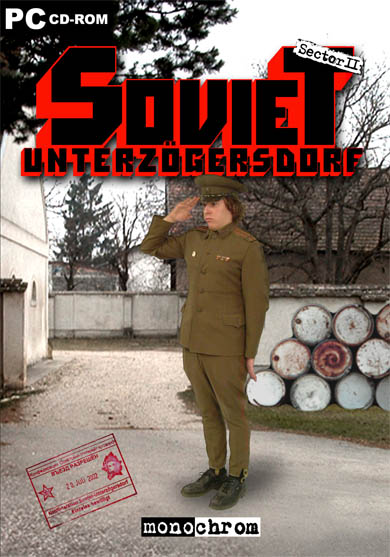
We transformed the theoretical concept into an improvisational theatre/performance/live action role-playing game that lasted two days. That means we really organized bus tours to Unterzoegersdorf — a small village that really exists — and acted the setting; beginning with the harsh EU Schengen border control. Later, in 2004, we started to think about a possible sequel to the performance. We thought that the cultural format of the “adventure game” provided the perfect media platform to communicate and improve the idea.
We started to work in February 2004 and presented ‘Sector 1’ — the first part of the trilogy — in the form of an exhibition in Graz/Austria in August 2005. We released ‘Sector 2’ in 2009, featuring guest stars as Cory Doctorow, Jello Biafra or Bruce Sterling. As the game series uses a 3rd person perspective with photo backgrounds and pictures of real actors as sprites, it took us quite a while to digitize and image process all of the material. This technique was actually first used by Sierra On-Line during the early and mid-1990s — but we are quite proud that we managed to get the feeling of discovering an old computer game that never existed on your old 500 MB hard drive. One aspect of the game is playing with memories and the future of the past. The future is a kind of carrot, the sort tied just in front of the cartoon donkey’s nose so it goes to work, goes off to war, learns Javascript and knows which bits to laugh at in Woody Allen’s Sleeper. You can imagine.
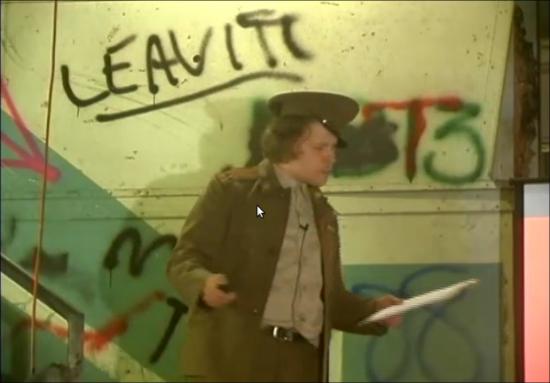
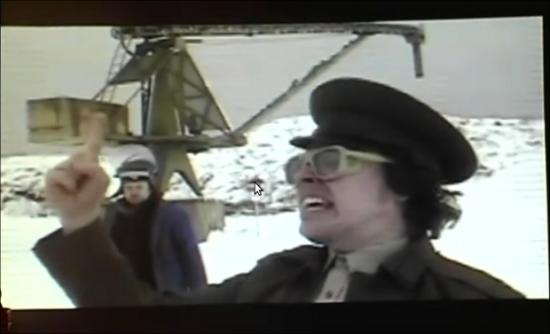
At a HOPE conference a few years back I was interested to hear you talk about the framing of the project as somehow deeply connected with a certain understanding of historiography that you and the other members of monochrom share. Could you elaborate on this a bit?
Debates triggered by postmodern culture have directed our attention towards questions of representation and the relevance of “history” and stories — i.e. The challenging proclamation of a post-histoire, the realization of the impossibility of a meta-narrative of history; the clash between reality and sign systems, the difference between fact and fiction, the impossibility of neutral contemplation or witnessing as well as the positioning of subjective awareness within such representations, etc. All these forms of representation have been playing a central part in the development of national, ethnic and tribal identities since WWII. And (as a by-product of military technology) computer game development is hardly aware of these discourses.
We wanted to combine (retro)gaming and (retro)politics and (crypto)humor to delve into this ongoing discourse. We wanted to harvest the wonderful aesthetic and historic qualities of adventure gaming. It is a commemoration and resurrection, and one more reminder that contemporary gaming (in its radical business-driven state-of-the-artness) should not dare to forget the (un)dead media of the past — or they will haunt them.
If you compare the status of the adventure game in the context of the economic growth of the computer game industry you could state that it is gone. Less than 1% of all computer games written are adventure games. Adventure games are nearly extinct… but only nearly. If media and media applications make it past their Golden Vaporware stage, they usually expand like giant fungi and then shrink back to some protective niche. They just all jostle around seeking a more perfect app.
For many people in the Soviet Unterzoegersdorf team, adventure games are part of their media socialization. For the computer industry it is one of the most successful gaming formats of the past. And for the feminist movement it is proof that a woman — I’m talking about Sierra On-Line’s Roberta Williams — was able to shape the form of a whole industry totally dominated by men.
Computer games are embedded in the cultural framework of technological developments. In the study of technological development and creativity, focusing attention on the failure, the error, the breakdown, the malfunction means opening the black box of technology. Studies have convincingly demonstrated that the widespread inability to understand technological artifacts as fabricated entities, as social and cultural phenomena, derives from the fact that in retrospect only those technologies that prove functional for a culture and can be integrated into everyday life are “left over.” However, the perception of what is functional, successful and useful is itself the product of social and cultural–and last but not least–political and economic processes. Selection processes and abandoned products and product forms are usually not discussed. According to Langdon Winner, there is a sense in which all technical activity contains an inherent tendency toward forgetfulness. Quote: “Is it not the point of all invention, technique, apparatus, and organization to have something and have it over with? (…) Technology, then allows us to ignore our own works. It is license to forget.”
Could you also perhaps talk about the choice of selecting the genre of an adventure game as the incarnation of this downtrodden republic. At the risk of being literal minded, is there any sense in which the existence of ‘Soviet Unterzoegersdorf’ as a kind of place that comes alive through players’ interactions with a program downloaded from the internet has anything to say to how you imagine being able to engage/critique/disrupt the idea of the nation-state?
We are postmodern leftists. A little bit melancholic… but you can count on us. We love to play with layers of consciousness and layers of layers of consciousness. On first view our project could be interpreted as a mock-up of the Soviet Union and the communist state structures that really existed. But, why on Earth do we need so many references to 1980s and 1990s metal music? Or Marvin Minsky? Or Negri? Or Austrian post-WWII history? Or geek adumbrations? Mocking the Soviet State would be much easier. In fact it’s about the wonderful clash between reality and sign systems, the impossibility of neutral contemplation or witnessing as well as the positioning of subjective awareness within such representations. The traditional humanists tend to see the whole philosophic aesthetic postmodern line of thought — from Judith Butler to Lyotard and Derrida — from the wrong angle. Okay, you can’t explain Sun Ra to a Green Day fan now, when he’s laying in the corner, piss-drunk and crooning “Anarchy”. But we think that the (radical) nature of postmodernism is often simply not grasped because people just copy it down into the conservative pattern of thinking which has been indoctrinated into us since the Enlightenment. Of course, on the other hand, it functions as a virus, and there’s nothing wrong with that.
Contemporary art — the field we are usually working in because there’s money — is mostly concerned with systems or systematic concepts. In the context of their work, artists adapt models of individual art-specific or economic or political systems like in a laboratory, to reveal the true nature of these systems by deconstructing them. So would it be fair to say that by their chameleon-like adaptation they are attempting to generate a similar system? Well… the corporate change in the art market has aged somewhat in the meantime and looks almost as old as the ‘New Economy’. Now even the last snotty brat has realized that all the hogwash about the creative industries, sponsoring, fund-raising, the whole load of bullshit about the beautiful new art enterprises, was not much more than the awful veneer on the stupid, crass fanfare of neo-liberal liberation teleology. What is the truth behind the shifting spheres of activity between computer graphics, web design and the rest of all those frequency-orientated nerd pursuits? A lonely business with other lonely people at their terminals. And in the meantime the other part of the corporate identity has incidentally wasted whole countries like Argentina or Iceland. That’s the real truth of the matter.
Read Part 2 of this Interview
http://www.furtherfield.org/features/interviews/interview-johannes-grenzfurthner-monochrom-part-2
Read Part 3 of this Interview
http://www.furtherfield.org/features/interviews/interview-johannes-grenzfurthner-monochrom-part-3
Featured image: An interview with Chris Dooks, a ‘Polymath’ exploring various creative avenues, making his art using different media.
One of the many interesting and rewarding elements of being deeply involved in what, I’ll loosely term as ‘media arts’ practice, is the breadth of imaginative people you meet along the way. We first met Chris Dooks in 2005-6, when he worked with us on a project by Furtherfield called 5+5=5. We commissioned 5 short movies about 5 UK-based networked art projects exploring critical approaches to social engagement. These pieces offered alternative interfaces to the artworks and the every-day artistic practices of their producers. Including the motivations and social contexts of artists and artists’ groups working with DIY approaches to digital technology and its culture, where medium and distribution channels merge. Chris produced a film-work for the project called Polyfaith. A Psycho-Geographical Web Project introducing the beliefs and philosophies of his (invented) friend Erica Tetralix.
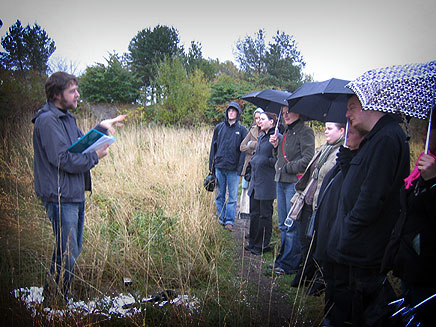
“My friend Erica Tetralix died. She gave me the task of fulfilling her dream which was that people would enjoy the parts of Edinburgh that were so dear to her in her life. She also loved tourists and sympathised with people on a budget, so she devised, with my posthumous help, this free way to enjoy the city. It’s a beautiful gift for both transients and residents. It’s popular with backpackers, parents and children, cultural groups and well, basically anyone.”
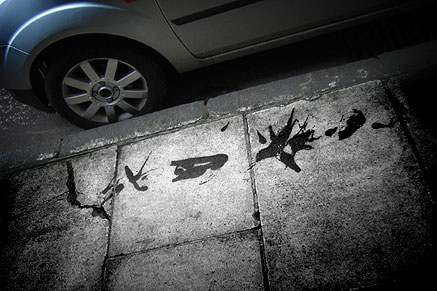
Later on we discovered that the name Erica Tetralix, is actually a name of a plant. Often called a cross-leaved heath, a species of heather found in Atlantic areas of Europe, from southern Portugal to central Norway, as well as a number of boggy regions further from the coast in Central Europe.
To view Polyfaith visit link below:
http://furtherfield.org/5+5=5/polyfaith.mov
The value of an interview is that it can serve as a useful documentation, a process allowing a kind of unfolding of time, All layed out in front of you. The reader can experience not necessarily a retrospective, but a dynamic and creative life and a personal history openly shared, on their own terms.
This interview reveals various levels and approaches by Chris Dooks. An inquistive and playful mind is at work here, engaged in exploring across different forms of personal agency, as well as redefining his practice in relation to the world he exists in, and the people he comes across in connection to various projects. His art is not a singular activity. Meaning, he does not rest in one particular art genre or movement. Instead, we are asked to acknowledge a personal enquiry formed from different engagements and choice of mediums, which happen to meet his creative intentions and questions at the time. We are all relational beings and Chris Dooks is a clear example of how this can work in an artistic context.
The Interview:
Marc Garrett: Many out there will already know you as a professional film maker, directing arts-based TV documentaries such as The South Bank Show in your twenties. Since then, you have developed other skills involving design, composing and making music, audio visual installations, explorative psychogeographical projects, as well as continuing making films, and you’ve even got a record deal. You have as far as I can gather four different music projects curently on the go, your electronica group BovineLife, an architecture music project known as As Ruby’s Comet, Feible for laptronica and also the Audiostreet project featured at The Leith Festival.
Chris Dooks: It’s amazing how many people still know me from Bovine Life which was a moniker I used for an internet audio project way before broadband in 1999. It’s the tenth anniversary of my bip-hop album SOCIAL ELECTRICS and I would like to make all my albums available for free for furtherfield readers. Don’t let itunes rob me of any money! The transition to musician was down in part to the South Bank Show when working with Scanner. I was really frustrated at making work about musicians. And the technology was making it easier for folks like me without a classical training. Here are three for you for free – check links below for free tunes at the bottom of the interview.
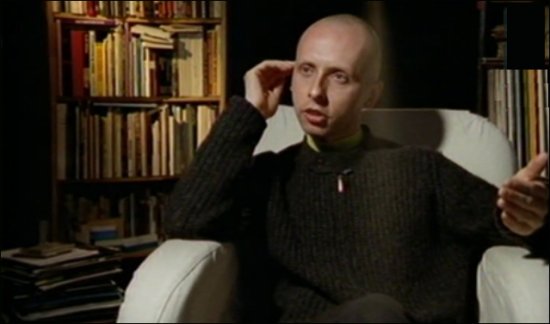
South Bank Show UK television documentary directed by Chris Dooks, featuring Robin Rimbaud speaking about his practice and ideas. 1997. Click here to watch video.
MG: In The Glasgow Herald, in Scotland a journalist called you a Polymath. Even though you were delighted to receive such a compliment in the local press, you decided to re-edit the term, reclaim it so to make it less seemingly mathmatical. Prefering Polymash because it sounds “friendlier, resourceful and potentially charming.” Sticking with this notion of you being a Polymath or rather a Polymash. Your diverse approach in creating art works in a non-singular approach, is a core element of your practice. I was wondering whether this is a deliberate decision or a natural and overall state of being?
CD: It’s weird though, I learned more in my background as a wedding videographer aged 14-19 (35 weddings at weekends!!!) than on any other course. Doing weddings gives you various skills as a digital artist. Fuck a film degree! As a wedding videographer, you need to be able to mike the vows in difficult audio environments (i.e. reverby spaces), film it about fifty feet away, liaise with highly emotional temperaments, be like a war photographer – it’s only gonna happen once, miss it at your peril – and stay sober. Not to mention edit it at a time when non-linear editing was non-existent, (I remember the heady days of “crash editing” between two panasonic VHS machines) white balancing everything on manual heavy equipment and creating all the graphic design and labelling of tapes. I was like a teenage record label!
So in 2009 when I made www.studio1824.com – making a record (netlabel) for an icehouse in Sutherland (remote Scottish Highlands) I got a kind of deja vu experience. Only with an education and life experience in the mix now.
When I was 8 years old, I had two epiphanies. One was that death is really gonna happen, and two, that cinema is wonderful, emotional and that it offers us a naive form of immortality. Cinema was the only artform that even at that age, I felt could make me feel…spiritual, for want of a better term. I became quite religious.
I was obsessed with super 8 cameras and video. And now I am trying to get all my pre-teen works tracked down! But even at this stage there was always a healthy distraction in other areas. I wouldn’t get involved with narrative and this has never been my strong point, even though I was reasonably good with words. My uncle played a lot of classical music and my dad took me all over the UK in his lorry, and at this time I won a scholarship to play the cello at school with the posh kids, being the other three. (It was a working class music “initiative”) But alas, I didn’t realise how lucky this was for me. So I went back to making videos, this “poly” approach was probably set quite early. I remember doing a kind of pre-Blair Witch thing when I was 14 and I would get sidetracked into filming the shapes of the leaves and the sound of the wind. Then I realised that the material didn’t make sense in the conventional sense. So I became an aesthete of kinds at an early age. And in every way, from Granny’s trifles and an early lust for Kate Bush, I was concerned with the sensual world. But until 22 I was monogamous to film projects and would work as a corporate director in the art school holidays to fund my college life, with the odd wedding video thrown in. By the time I did my film degree at Edinburgh College of Art, I was much more interested in people like video artists Bill Viola, Gary Hill and Daniel Reeves – (I met all three) via the “team-building” world of film shoots. Bill Viola’s THE PASSING changed my life.
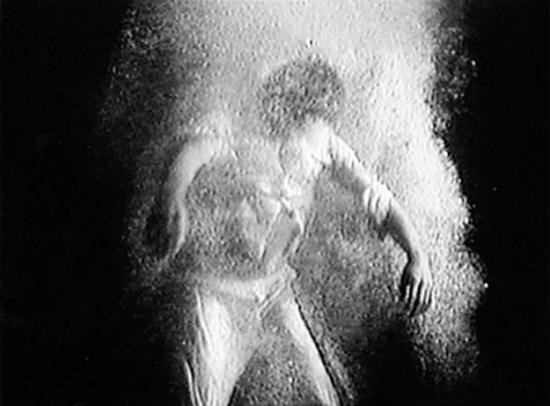
The Passing, 1991. In memory of Wynne Lee Viola. Videotape, black-and-white, mono sound; 54 minutes.
Pre-degree, in those days (1989-91) you had to REALLY know your kit and be a good all rounder. I trained on huge Umatic machines and did a BTEC before a degree. I was from a part of a culture where there was no film degree, and I was a couple of years behind my peers. But by the time I hit ECA, I could mix radio programmes, edit timecode, black and white balance studio cameras and location kit and I spent most of the time buggering off to the hills to film Scottish waterfalls. I might have been techinically proficient and this was behind the poly approach to an extent, but I had bugger all conceptual skills. These have only really solidified in my thirties…
MG: Lets talk about the Surreal Steyning psychogeographic audio tour, part of the The Steyning Festival in 2009. On the web page for the project is written “This tour is simply a different way to skin the proverbial cat. In this case, the cat is Steyning. In fact, if you think of Steyning as a cat, you are already a psychogeographer. Well done. You’ve engaged your psyche with geography. You’ve mapped the town conceptually. The High Street becomes the cat’s spine with the head chasing Mouse Lane. Now you are in the same company as such artist groups as the Situationists, the Dadaist Movement and other high fallutin ripples in art tourism, and even The Ramblers.” Did those who took part manage to understand and appreciate where you were coming from? Also, how did it work?
CD: There was a tiny degree of spin with the site’s headline Traditional English Town Embraces Conceptual Art Walk but by and large folk did embrace it and it would have been patronising not to drop a little sand in the vaseline, not to deliberately challenge, because the Steyning Festival, was, I felt, in danger of being a little like a tasteful village fete. A good fete I might point out, so this year, there was something brave about them putting a conceptual artist at the heart of a residency in the village. English villages like Steyning were not and are not, all tasteful. Whenever I encounter these tasteful expectations in the arts, I think of that Stereolab song, Motoroller Scalatron with it’s chorus “What’s society built on? It’s built on blood. (some say the lyric is “bluff” not blood but either way it works)” So I saw my role not as a socialist historian, because I wouldn’t have a clue, but as someone who encourages an enquiry per se into unusual histories, paganism, aesthetics and philosophies of very local travel. I mean, I don’t think there’s anything angry or unloving in the tours. In fact, I try to make them about folk being nicer to each other. These activities have a small socialist agenda but as a performer, I am not exactly Stelarc, slashing my wrists in the street. I’m not about shock! However, this tour had a couple of “jaw droppers” (See The Steyning Star on the tour). The main outrages came from people who wanted a straight history tour and were not given one, depsite my first words on the tour saying “this is NOT a history tour!”
Example taken from section 4 of the The Steyning Star on the tour:
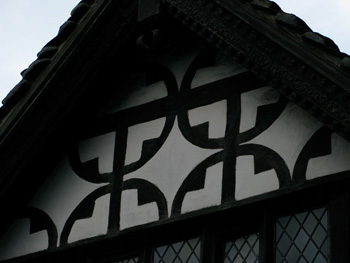
“This is Brotherhood Hall, built in the fifteenth century and now part of Steyning Grammar School. Look closely at the symbols which adorn the gables. They may look like simple decoration to us, but these markings are rather unusual. They have been the subject of no fewer than three PhDs, and for a century the world’s leading symbologists have engaged in hot debate over how to read the meaning of them. One of the most important questions is what shape we are dealing with. While some people see predominantly circles, others see squares and diamonds, rather like those tiles that everyone had in their bathrooms in the 1970s.”
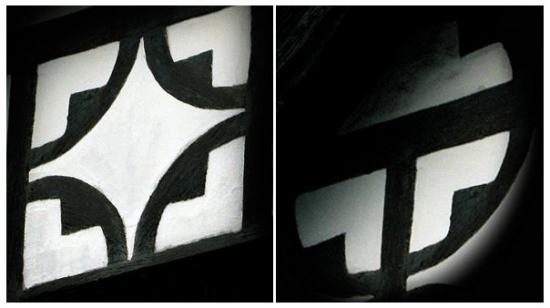
“Was this a pop premonition? For some time it seemed so, and this remains a strong theory. But in the mid 90s the school took part in a German exchange programme, and visiting German students proposed yet another alternative. When they looked at the patterns on the gables they saw a cross drawn within the circles, or a gammadia, to be more precise. A gammadia is a cross voided through, or a cross formed with four of the Greek letter Gamma. It looks a bit like an ‘L’ to us. The swastika is the most famous example of a gammadion. The German students believed that this was not a pop premonition at all, but a foretelling of the success of German heavy metal band Gamma Ray. This theory also gained popularity among members of the school’s very active astronomy club.”

The festival had hired a PR person to market aspects of the festival and commission an artist, and so I was brought there with a little Arts Council of England fund, so felt obliged to make work with the tools I’ve been developing – or my “brand.”
Nothing was watered down simply because it was a village (it’s actually a town but it feels like a village) because it would have meant compromising the ideals or enquiry, of looking deeply and into the areas of my interests of paradolia (faces in chaos) and simulacra formations (things that appear to be other things).
Most of them got it! I mean, it was nearly two hours long and they stayed till the end, although it did split the audience, but not badly. 2-3 out of 20, left. We had to do it again the next day due to popular demand! The ones who stayed had smiles on their faces by and large, which made me very happy. The weird thing was, not once had it been stated that it was a “straight history tour”, and it should have been obvious within the first thirty seconds that I make some of the stories and hypotheses so outrageous that surely this is tongue in cheek? However, I had written some slightly anti daily mail sentiment in it and two or three people angrily walked out of the tour. I got that wrong. It’s a Tory (conservative) heartland, and I don’t think you can be an artist and right-wing, you are just too aware of the world, but I should have considered this aspect more.. My landlady was one of the people present in the audience and she walked out, that upset me a wee bit.
But there’s something about my personality that makes people trust me in my tours, folk are quite sweet and gentle perhaps. The message behind the tours is one of re-imagining everything you hold to be true. The motivation behind these tours is to see travel as something that can be done anywhere. People go to the other side of the world to enrich their lives, many don’t even journey over to the other side of the street, or drive through a different part of town! I find that hilarious. So for me, psychogeography is about the chicken crossing the road..
If we can’t even do that, what hope is there for atheists like me (who find Buddhist philosophy and its practice the only religion without the conceit of the other big hitters) who are forced to approach the world from multiple angles, because we can’t accept the idea of monotheism and monotheistic thinking. This single mindedness of approach, when challenged (not just in religious people, but people stuck in their ways) is bound to create a bit of friction even on a playful level like in Steyning.
I became invloved in Surreal Steyning based on another project, in Brighton, where I made several songs about a building on Brighton sea front. This was a song cycle, based on a very specific bit of geography.
There is this idea that psychogeography is only urban – but I prefer to bring this intense work to the home counties! After all, the whole point of being an artist is to see through the privets, the darkness of the forests. So while I was in Steyning I was reading about Alistair Crowley and witchcraft and when Steyning used to be a port – it’s now land, ten miles inland! In the middle ages everything was different. I think a lot about how many contemporary English folk in these wee villages don’t realise their own foundations. I found Steyning a really charged place and not just a twee place to get (admittedly excellent) cream teas and real ale (a bit flat for my northern British palette).
This was, without a doubt though, the most successful public psychogeography tour I had done, even more than Polyfaith. There have only really been three tours – Polyfaith, Select Avocados and Surreal Steyning. And Surreal Steyning learned from the other two – so I had my schtick by then. I think it’s the best executed one so far. Let me be clear, I care about the audience. I adapted to their demographic, their language and their refinery in this tour, but I really care about people, but what I hate is bigotry and there was a little bit of friction about some of the left-wing ideas in the work and some of my own goals. But they needen’t be upset by a Middle East reading of a thatched cottage, the similarities of Tudor graphics and the 1990s version of the Take That logo, and the roof of some flats that might look like an arrow.
MG: This critical approach of consciously making room within yourself to understand or at least appreciate the sensibilities of others, surely it must be a difficult task to accomplish? What I find fascinating about your engagement with the public is the measure of respect for them, mixed with a healthy level of detournement.
Thanks! I actually think it’s a big complement to have the public stay on a tour for up to two hours, or buy one of my records. So I’ve really tried to attack attention-deficit tendencies whenever possible. It’s also my grammar. I don’t really do critical theory, although to apply for money you need to know where your bit of culture fits in with others. I really dig a good bit of popular culture. I think the best stories in our culture in the UK can all be seen on Jimmy McGovan’s The Street. He is a master of audience respect. Also, I feel confused by a lot of art, so I like to call a spade a spade, unless I am in a surreal mood and I’ll call it a Sad Ape (Sad Ape is an anagram of A Spade).
I had a slightly uncomfortable childhood and adolescence That “public” thing comes from Teesside. I also particularly like North of England humour – and actually I really like it when “clever shits” (to quote my Granny RIP) get usurped by that kind of spit-and-sawdust philosophy. There’s something survival-like and super-clever about grass roots humour because it comes out of neccessity. So I think my own personality is a bit of art school but with angry chips on both shoulders. It’s why working in Scotland is great, because the Scots hate bullshitters – especially the Nathan Barley set. I always found that very attractive. I remember seeing and being heavily inspired by Vic Reeves and Bob Mortimer’s first series and thinking, this is a dangerous combination! Northern swagger and charm! Dada! but with more academic kudos than might appear at first glance. And it was bloody funny! It was both alienating and accessible at the same time.
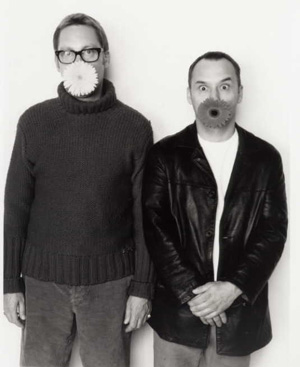
I grew up in Teesside and North Yorkshire and school never encouraged me really. I never had a bohemian upbringing, but I believed in the soul and went to Sunday School (my own choice – I was very religious for a kid). But I probably owe my interest in orchestral and “difficult” music to my uncle, and this was partly my first exposure to other worlds – I was particularly inspired by Bach’s Toccata and Fugue in D Minor. And I liked that piece because it had something I could relate to (the church organ), it felt something otherworldly – both the sustained drones and mechanical math-like, transcendental nature about it. And no words. I remember talking to my music teacher about it. She got all excited and presumed I could play it so she got me the sheet music to learn it. But I could never do it, I had no discipline. Anyway, that piece was amazing, spiritual to me. When you thought it couldn’t end, it changed scale and key and ascended to even more articulate heights, clever and gorgeously aesthetic at the same time.
I failed art. I grew up around lorry drivers, grandma’s trifle and Christmas at working men’s clubs. A lot of nice memories but I’ve always been looking for ways to sweeten the sour ones. And then, a huge affliction came. Around twelve, I started to have these really strong life changing shocks, like my psyche being ripped to shreds – just by thinking, enquiring, looking deeper. I would call them “dark epiphanies” later. They are still with me. Adulthood has not softened them. I’m always on the lookout for liberation! Like Russel Crowe in A Beautiful Mind he learns to live with his Demons and accept they are there! I’ll never get over these mortal messengers, but it’s what underpins all the puns and humour in the work. Tears of a Clown maybe? At the time, (aged 12-15) there were pennies dropping about mortality – real hopelessness of mortality. I’m still dealing with it. The problem is, because these visceral thoughts will never go away, I have started trying to make them my teachers. And all I want to do across all of my works is reduce anxiety – mainly my own – and look at multiple universes – and I think we forget that your street is part of the universe. That’s where the work begins, in your block, your local Lidl – these places should teach you as much about our ridiculous situation as anywhere else. It’s like that idea that “the environment” is outside somewhere, when really it’s in the most mundane places. The mundane is “supramundane” at the same time. It’s no wonder I became a Buddhist in my early thirties. I need to get back into it. I’m getting somewhere maybe.
MG: Perhaps, it is not just about re-inventing a selection of different mythologies, histories in relation to localities, whilst exploiting contemporary mediums; which includes elements of satire, a certain level of hyper-reality.
CD: I think it’s about a hatred of authority, not because we don’t need order, I think we do, but authority takes all the colour out of our history and culture. I watch X-factor, like Peter Kay (underrated surrealist like most comedians – despite the professional Northerner get up). I never liked punk and thought anarchy was really stupid! Civil disobedience maybe. I hate it when I see musos on the telly talking about punk, getting all nostalgic. Maybe the Clash. Maybe it’s the patronage of culture by high fallutin’ types I don’t like. Because patronage kills proper culture doesn’t it? And because of that, I never got passionate about history at school. It was a bit grey. So what do I do without the arsenal of the passionate historian? I make bits up and flirt with it. These projects mean I have to know bits of history now. And this bit is really telling – the bizarre thing about the hyper-reality aspects of my tours and other works – is that the bits I make up and flirt with – those bits are often scarily close to the truth. Also you say I’m really respectful to the public, but I like to push it a lot. In Edinburgh, on the Polyfaith tour, folk were swallowing my wildest tales about the city when they’d lived there all their lives! I came in under the radar I suppose. I like usurping the pompous stuff with a passion though, I really do, I feel it’s my duty!
MG: There seems to be a kind of niggling question in this work. I get a sense that this question does not only relate to asking those who take part, but also yourself. It touches upon something quite raw, authentic and complicated, and untouchable at the same time. I am not referring to the sublime here, it relates to all of our collective histories, on this earth. A Genealogical form of re-assembling, re-knowing and perhaps not knowing. Are you trying to make contact, or reconnect some how to a type of authenticity; if so, what does this look like in respect of your intentions?
CD: I want to find spiritual relief. That’s a terrible word – maybe the sublime is better. Fuck it, I want it back from the New-Agers. Even though I am a total Dawkins fan, and am partly liberated by looking deeply, I just want a bit of peace really. And the tours train me to think outside the box, that’s it. I suppose it’s like doing my own philosophy degree “in the field.” But there’s a bigger box I am being prepared for (see what I did there!). There’s not much relief. I am a highly charged person – some would say high maintenence! I’ve just seen the Andromeda galaxy from the back garden. I want more of that. This is a really hard life. I want to be less fat. I’m sick of having M.E. My wife is pregnant. Christ, I am going to be a father. Maybe that will help my afterlife woes. Men aren’t supposed to moan. I’m being genuine here though. I forgot to mention Derren Brown. I’d love to do a project with him. I am sorry these answers are not very articulate. It’s in the tours! Do them!? Seriously, do the tours.
MG: What qualities and values do you think or feel this form, process and working offers yourself, the world, art and culture on the whole?
CD: I look at my place in the digital arts as a priest being sent to a remote parish – so hopefully we’ll clean up here in Ayr, our new home! ha ha! A lack of funding might make that difficult but it hasn’t stopped me before. My current thoughts are… Paradolia and Simulacratic Forms as narrative agents for psychogeographical tours. The benefits of the sustained drone in music. “Dayglow” hues and man made fibres in landscape photography. High hills. The idea, place and value of the troubador in the present age and the potential of “singing the news” as a deterrent for media-saturation. My next project may be about folk-music and psychogeography, using local folk clubs to make popular songs based on themes by bloggers. Some of the things I think of, I sometimes see being made around the time. A bit of Zeitgeist, collective unconsciousness awareness maybe! I am also still digging around popular atheism and the atheistic roots of Buddhism. Folk-Art and the search for genuine Scottish culture as opposed to the much-touted facsimile. These are my daily concerns. A project that I should mention is Ayrtime. A series of eclectic cultural events presented in the heart of Ayr, Scotland. Gigs, Theatre, Literature, Astronomy & more – on this site you can find archives of the events with beautifully crafted podcasts!
My work offers me the stuff I was told at school really. No different to building or plumbing on one level. Just a sense of achievement and pride I suppose. Quite traditional aims. I remember a conversation with my dad in the last few years (we row a lot) in The Ship Inn in Marske. I asked him why he never wants to know about all these fantastic projects I’d done! And he said “Well that’s your work isn’t it? If you were a plumber we wouldn’t be sat here discussing U-bends” and at first, I felt slighted, I’m not a plumber I’m an ARTIST goddammit!! It made me think of The Cohen’s Barton Fink, human and pretentious character “The life of the mind, there’s no roadmap for that territory” but on reflection it’s quite good to be making this mad work in working class areas, to take my artist ego down a peg or two. Lord knows I need it sometimes because I have two fights generally – the first is the fight to get work funded and made and promoted and so on and it be stimulating work. The second is the fight with M.E. which I feel like I am totally on my own with a lot of the time. I get really unpleasant symptoms, often with no break for weeks on end. Sometimes I can only do 30 minutes of work in a day. Sometimes, even that is a pipe dream. I’ve had twelve years of this shit. I was directing arts documentaries for telly when I was well. The upside of the M.E. is that it is humbling. I’d probably be that Nathan Barley wanker by now, and I wouldn’t have touched the Buddhism, the philosophy, proper art and gotten arts council funding without the lessons I have learned.
Social Electrics 10 year Anniversay edition 1999 – bip-hop.
You Know, You Love Something Little – Lost Vessel 2002.
The Aesthetic Animals Album 2008 – benbecula records.
www.eleanorthom.com
www.karencampbell.co.uk
www.alanbissett.com
http://www.louisewelsh.com
We Feel Fine: An Almanac of Human Emotion
Jonathan Harris and Sep Kamvar
Scribner Book Company, December 2009
ISBN 1439116830
Featured image: We Feel Fine project poster
“We Feel Fine – An Almanac Of Human Emotion” is a hardback book that in just under 300 pages of well designed montages, data visualisations, diagrams, illustrations and text presents and analyses the data gathered by the We Feel Fine project. Started in 2005 and launched in early 2006 by Jonathan Harris and Sep Kamvar, We Feel Fine is based around a database assembled using a webcrawler that searches the blogosphere for statements of the form “I feel” or “I feel like”. Any matches are stored along with as much contextual data as the webcrawler can find (a photograph nearby in the blog post, the poster’s age, gender, and location, local weather). The database contained twelve million such entries by the time the book was published.
Sections of the book categorise statements of feelings by age, gender, the location of the poster, and subject of the statement. Individual statements are presented superimposed over images found in the same blog post. The photographs presented with their accompanying expressions of emotion have a high-contrast, shallow depth of field, and highly focused look that resembles Lomography. But this is a product of the presentation of photographs on the web rather than an hipsterly ironic invocation of the contingent aesthetics of mass photography. The images are for the most part JPEGs, and show the contrast, mach banding and visual noise of that technology.
The montages of “I feel…” statements in a standard format superimposed over an image found in the same blog post serve to provide a (sometimes incongruous) context for the statements that the project is based on. They resemble Gillian Wearing’s “Signs that say what you want them to say and not Signs that say what someone else wants you to say” 1992-3 featured photographs of people holding up placards on which the artist had asked them to write down what was on their mind. Going back further into the history of art, the montages and in a novel way particularly the data visualisations and graphs bear comparison to Vermeer’s seventeenth Century paintings of bourgeois social relations and reverie. Both “Girl reading a Letter at an Open Window” and “We Feel Fine” present social class, social self-presentation, advanced communication technology and consideration of the thoughts of others in a medium and way that epitomises the way people see things in that era.
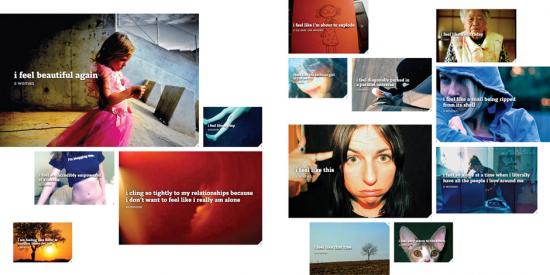
The book’s volume of data and graphics quantifying social phenomena might resemble a “state of the blogosphere” corporate social media report in some ways, but its presentation directs attention back to the emotions featured rather than trying to tie them to any corporate or governmental agenda. This is a book by, about and for individuals in contemporary mediatised society. I found reading it became quite overwhelming sometimes once I had adjusted to its presentation.
Dictionary definitions, statistical breakdowns of the kinds of words, ages and genders of bloggers and other demographic and affective data are presented in compact graphic form on every page, and larger charts show more general conclusions. Feelings, or the words used to refer to them, are shown to vary between genders and as people age. This is an exemplary application of Edward Tufte’s science of the graphical presentation of information. They even have sparklines. But that science is applied to data that is at its heart qualitative rather than quantitative.
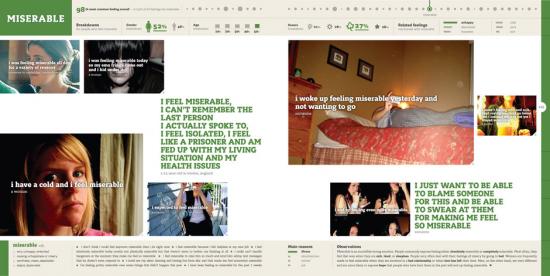
Such “data visualization” was a hot trend in 2009. Visualisations of crime rates, corruption, climate change and other issues can be produced using such data, and have become an important weapon in the arsenal of visual persuasion. On the We Feel Fine web site, feeling data is mapped to coloured blobs in an interactive user interface to the constantly updated (every minute) database. In the book, feelings and demographic information are processed to produce graphics that represent the prevalence of feelings over time, between genders, in different locations and in relation to each other. But as visual persuasion this is directed back to the vividness of human, qualitative experience rather than a more political or economic agenda.
“Sentiment analysis” was also hot trend in social media marketing in 2009 and its limitations quickly became apparent. Current systems simply cannot handle irony, sarcasm, regional differences in the usage of words and in many cases even simple negation. The We Feel Fine system is an exercise in gathering affective or sentiment data to visualise, but it avoids the pitfalls of sentiment analysis by automating only the gathering of the statements of emotion themselves, not analysis of how they relate to what they refer to. This is a classic example of well-chosen limits strengthening a project.
The problem of the relationship between qualitative (how you feel) and quantitative (how many people feel what you feel) data and how to deal with this in a non-voodoo way are avoided in We Feel Fine because of this.
Another 2009 hot trend was “big data”, the assembling of datasets that vary from many megabytes to many gigabytes in size. Datasets from regional and national governments, scientific research and freedom of information requests can be used in “data mining” to search for facts among the numbers. The We Feel Fine system is a good example of a big data dataset (and API, application programming interface, for accessing that data over the web). Unlike global temperature data it neither offers the possibility of objective accuracy nor involves any great risk if it lacks it. But it does reintroduce the human subjectivity that big data threatens to replace with numbers.
The striking thing about this is that although the We Feel Fine book is very much of the zeitgeist for 2009 the web-based system it presents started five years ago in 2005. At that time blogs were regarded by the mass media as disposable, narcissistic and somehow inauthentic. They were an unlikely subject at that time for art concerned with the authentic expression of emotion. We Feel Fine’s history, subject and results therefore both prefigure and go beyond the current state of the art in Internet social and corporate culture.
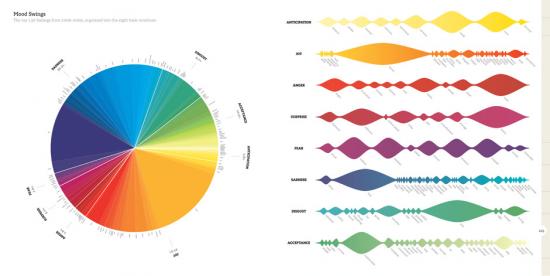
Harris and Kamvar are admirably candid in laying out the history, methodology, technology and in the case of the book’s production even the finances of their project. The code listings included in the book are tantalising glimpses into how the We Feel Fine server works, allowing a rare chance for students and artists to study such a system, and are licenced under the GPLv3. The book is under the obscure but principled Creative Commons “Founders Copyright” licence which will automatically expire the copyright on the book in twenty years time. This is all invaluable for critique and study of the project by artists, academics and anyone with an interest in art and technology, and more artists should do it.
In the FAQ and other essays contained in the book Harris and Kamvar are open about the methodological strengths and weaknesses of the We Feel Fine system. They acknowledge the limitations and demographics inherent in profiling bloggers (who are younger, wealthier and more technologically savvy than is usual). They also make a convincing case for the very real conceptual strengths of the project, discussing how the system holds up as science and statistics. And the project itself is overwhelming as an aesthetic and, strangely, somehow as a social experience.
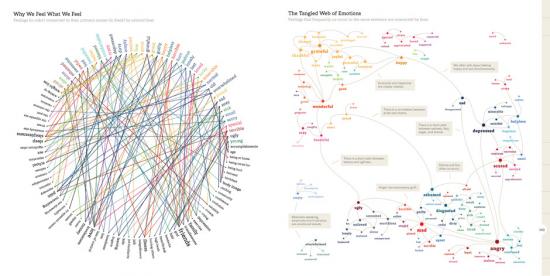
Even if we don’t deny or question the existence or status of emotions for ideological reasons, do we know what we really feel? And even if we do know what we really feel can we really express it in a way that will be understood by others? We Feel Fine doesn’t address these questions. They are outside of its scope. Its acceptance of sentiment at face value and its mechanical (re-)production of representations of sentiment might look like the hallmarks of kitsch. But that would deny the subjectivity of the original authors of the expressions of sentiment that We Feel Fine processes. And a progressive art needs to represent the masses, not merely rulers and pop stars. Not everyone will be feeling ironic or critical on any given day. Given this, the transparency, scale and effectiveness of We Feel Fine mean that ideological objections to big data, to emotional taxonomies, or to the very idea of emotion face a problem in the project’s aesthetic and affective success rather than vice versa.
Some of the stories found while researching the posts and presented in the book are heartbreaking or uplifting, but the statistical nature of the project makes these outliers – they are rare events and can be identified as such. What comes through from page after page of casual statements of feeling is an impression of the range of human experience, or at least the range of human expression. If you can adjust to the montage format and the diagrams then the book can inspire sympathy, pity, and joy for your fellow human beings.
The book ends by considering the philosophical and spiritual meaning of feelings, how they affect our lives, and what we can do about this. The data gathered to back up this consideration makes the conclusions both persuasive (this is a paradigmatic representation of humanity) and surprising (that would be telling).
We Feel Fine faces up to the challenge of making Internet art that realistically deals with the scale of the contemporary web. It does this by tackling the millions of daily new entries in the blogosphere but crucially it retains a focus on qualitative, subjective human experience. In its engagement with multiple levels and kinds of representation, from emotional taxonomies and statistical methods to digital photography, weblogs, and data visualisation, it shows just how broad are the range of systems and modes of depiction that artists can and possibly must deal with today. And it’s a project that simply wouldn’t exist if the people who made it couldn’t code.
We Feel Fine is a persuasive and insightful portrait of the individuals that make up the blogosphere. It can be overwhelming in terms of the amount of information and in terms of the volume and strength of emotion presented, but that is part of what makes it vivid. It is a paradigmatic, realistic and persuasive depiction of the qualitative experience of individuals within networked information society.
The text of this review is licenced under the Creative Commons BY-SA 3.0 Licence.
Inclusive filmmaking workshops to create a documentary challenging community perceptions of Grove Park Special School.
Participants: 20 students between the ages of 10 and 14 from Grove Park Special School in Brent
Artist: Michael Szpakowski (video artist, composer and facilitator)
20 students between the ages of 10 and 14 from Grove Park Special School in Brent explored and challenged community perceptions of the school in a series of visits and interviews with leading figures in the local community. The students, teachers, learning support assistants and Michael Szpakowski worked collaboratively in small groups to make a documentary film about the Borough of Brent, and the people who live and work there. Visits were made to 3 locations over 10 weeks: Brent Town Hall, Fryent Country Park and the nearby IKEA superstore. They were chosen because of their significance as providers of essential local community services. During these visits and interviews the students were encouraged to look outward and find their voices in the local community and throughout this process students and staff had the opportunity to learn valuable filmmaking and editing skills. The project has culminated in a DVD film, for distribution to all participants.
Partners: Creative Partnerships, Grove Park Special School